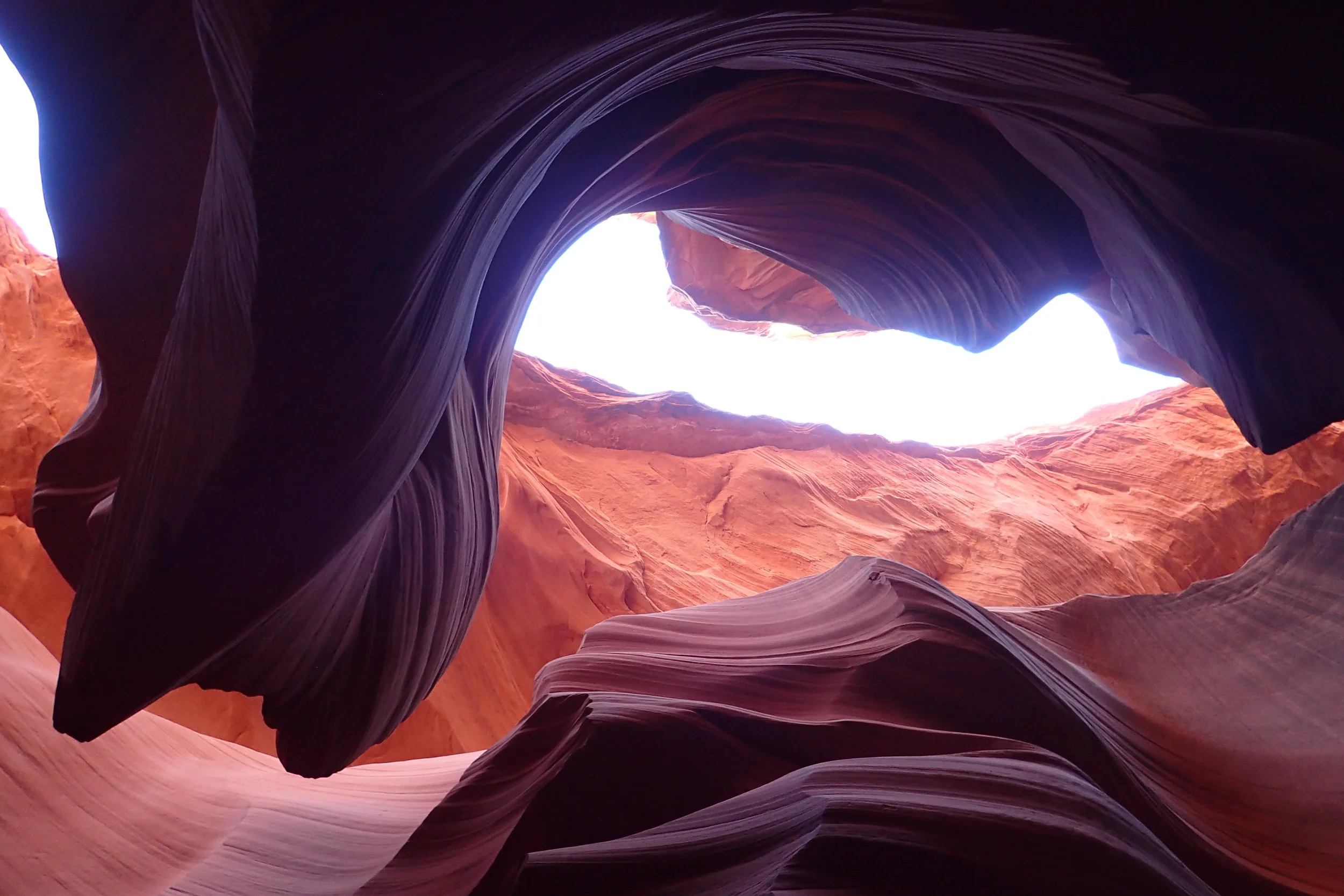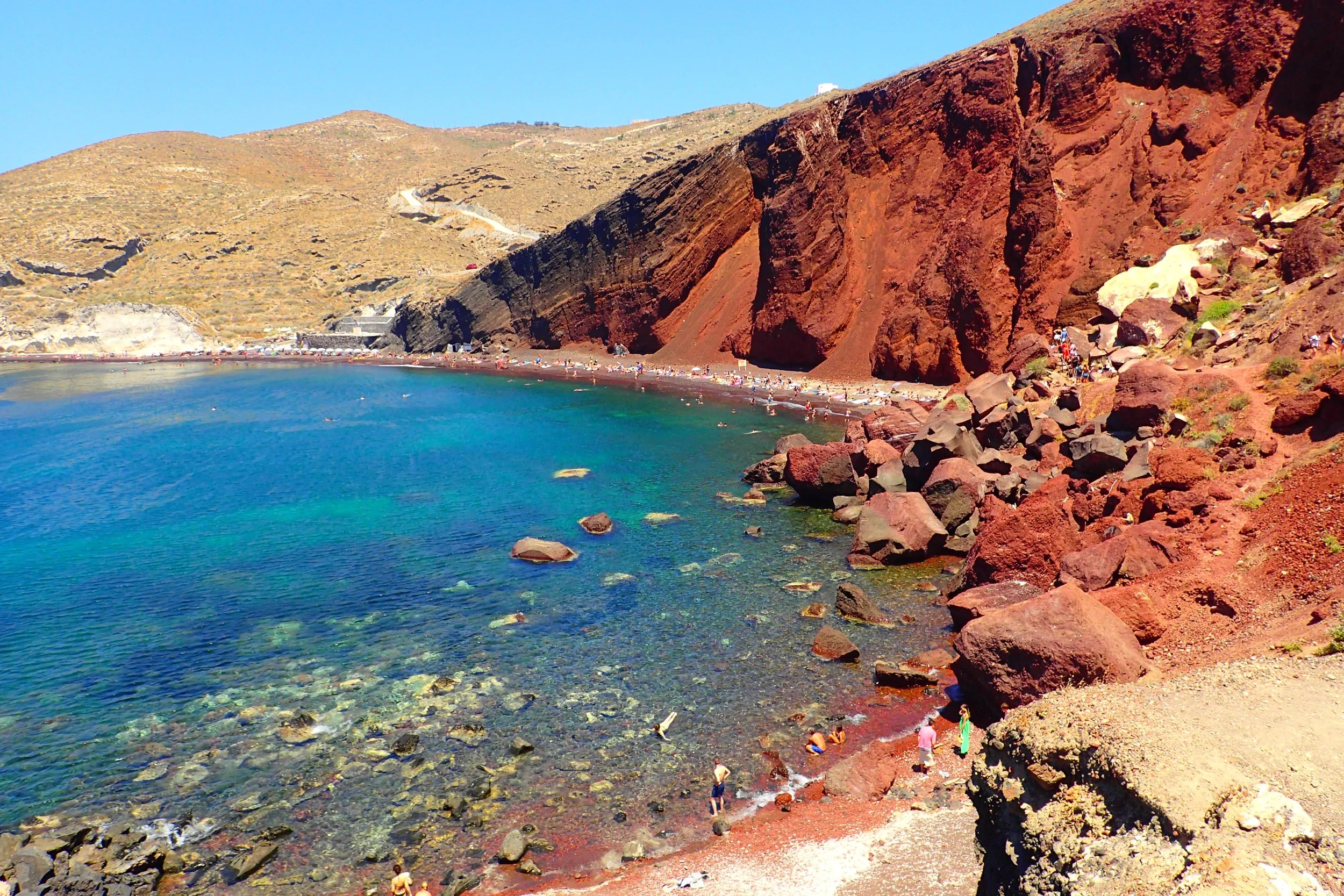It's a secret that was only exposed less than 90 years ago. Before that, Mother Earth had been busy painting waves into stone with water. The result is a photographer's dream location.
And the photographers show up in herds. This is why you need to know how I got to see it before all the crowds got there and without paying premium ticket prices.
In this post, I use my first-hand experience to answer everything you need to know about Antelope Canyon.
Why visit Antelope Canyon?
Antelope Canyon is the most famously photographed slot canyon in the world. Slot canyons are narrow passageways through rock.
Antelope Canyon's sandstone walls give the canyon a beautiful orange-ish hue. Light bounces off its twisting, swooping walls in a spectrum of sunset colors that are a feast for your eyes.
The experience of seeing this canyon first hand is magical. Hidden beneath the ground, you almost wouldn't know it's there. And you can't get to it unless a Diné (Navajo) guide takes you. So make time to check it out when you visit the southwest of the United States.
How was Antelope Canyon Formed?
Natural erosion formed Antelope Canyon like other slot canyons.
Flash floods from intense rains carved out this sandstone passage. Some wind and sand erosion also contributed to its shape over time.
It's pretty hard to tell exactly what's going on in there, even from up close!
Who discovered Antelope Canyon?
In 1931, Sue Tsosie discovered the slot canyon while herding sheep as a young Diné girl. Today, her daughter Carolene operates tours with Antelope Canyon Tours.
Prong-horned antelope herds roamed the area at the time of the canyon's discovery. This is where the canyon got its name.
Where is Antelope Canyon?
The closest city to Antelope Canyon is Page, Arizona. Antelope Canyon is on Diné lands off of Rte 98. There is a small airport in Page—an already popular destination. Page sits along the beautiful man-made Lake Powell.
The canyon is about 10 minutes from Horseshoe Bend. Horseshoe Bend is another popular spot for tourists and photographers. At Horseshoe Bend, there's a magnificent view of the Colorado River.
How to book an Antelope Canyon tour?
Do not book ahead for an Antelope Canyon tour. If you need a ride there, take a cab. Otherwise, drive over yourself and then book when you get there. This was the advice the tour company gave us when we called and it worked great.
The only thing I would advise you to do ahead of time is call ahead. Make sure they are still open for the day. Sometimes the tour companies will close down the tour. They close for weather-related safety reasons—e.g., flash floods or if it gets too hot.
Erin and I went at 3pm in the afternoon on a day that was reaching 105°F on the rental car thermometer. That's the cut-off temperature for holding tours. When we arrived, they had stopped taking tours into the canyon because it reached 115°F in the canyon.
We went back the next morning.
To our surprise, the morning turned out to be the best option! We were the first tour group to walk through. The air was cool in the early morning hours. This made the experience a lot better than it would have been the day before. I speak more on this below.
Make sure you go to the right tour company for the right canyon. Some only go to Lower Canyon and some only go to Upper Canyon.
Which Antelope Canyon Tour is Best?
You cannot go wrong with any of the tour companies out there. They all do the same basic tour even when you pay $150+ for a premium photography tour.
Erin and I chose one of the less expensive ones: Lower Antelope Canyon Tours – Dixie Ellis. We loved it especially because of our guide. He was great about getting us the opportunity to take lots of photos. He even showed us the best angles at which to take the photos.
What is the best time of day to visit Antelope Canyon?
I preferred the first tour of the day (at 6:10am) for several reasons.
First, our guide could take us through at his own pace. Another tour group came up behind us after about 20 minutes into the tour. Otherwise, there was nobody in front of us. So the guide was able to set a moderate pace that took us through in about 45 minutes.
Second, because we were the first group, the canyon was not yet crowded. I read many reviews complaining about how crowded and claustrophobic it got. And it's true. You're not going to get those gorgeous, natural photos when people are standing in the way of your shots!
Third, the temperature was perfect. It was the beginning of July and it was 105°F by 1pm each day. Going at 6am made it a cool, perspiration-free walk between the sandstone walls.
By the time we emerged out of the cave after 7am, it was already getting warm. And the crowds were already forming.
Which Antelope Canyon is Better? Lower or Upper?
There are a few of major differences between Lower and Upper Canyons to consider.
Lower Canyon is sometimes pegged as the more "adventurous" of the two canyons. The reason is that it has a more uneven floor with ladders bolted to the walls and stairs to climb at certain parts. But it's nothing too strenuous or difficult to traverse. If you have mobility concerns, go with Upper Canyon. But if you can handle walking up a ladder at home, you'll be fine.
Some consider Upper Canyon to be "better" for its photography. I only did Lower Canyon, so I can't say for certain if this is true. From what I hear, it has to do with the lighting. Upper Canyon gets more light beams. The most famous, most expensive photograph in the world captured one of the light beams in Upper Canyon. For those curious: Peter Lik took the photo and sold it for $6.5 million in 2014.
Also important to note is the price and the crowding. Lower Canyon cost us $25 while Upper Canyon is about $37. Upper Canyon will cost $50 for a 10am to 12pm tour that will give you the perfect light beam images. That's the tour where you can try to mimic Peter Lik's famous photo.
How to Photograph Antelope Canyon?
The most amazing shots are the ones you're not seeing if you are speeding through. Our guide taught us how to angle our cameras to get some of the most epic shots.
First, shoot your lens up toward the sky. Second, get your lens close to the wall. Your camera should be resting against the wall. Not only does this get a great angle, it also helps to stabilize your photos and prevent blurring.
This one would have been so cool if the person taking it in our tour group had stabilized!
Of course, a tripod would be best, but you won't have time to set it up properly.
With my simple Olympus TG-3 digital camera, I got shots like these:
It's almost difficult to make out what is going on in some of these photos. Is it a landscape? Is it a sunset? What is the actual size of those protrusions and peaks?
"The Whale" is the name given to this angle (apparently, this is also the same shot as an Apple desktop background!):
The layers of sandstone at these angles allow for your imagination to run wild!
There are other parts of the rock walls with interesting shapes to capture, too. For example, here's the face of a Navajo Chief:
And here are a few others I snapped normally as I was walking through:
Conclusion
Do not miss Antelope Canyon. It's a tourist destination outside of Page, Arizona—and it's spectacular. If you're in the area, take a tour to see one or both sections of the canyon. You will not regret seeing either one!
But don't get caught in the crowds! Get the first tour of the day to get those people-free shots. And have the rest of the day open to swim in Lake Powell! That post is coming next!





